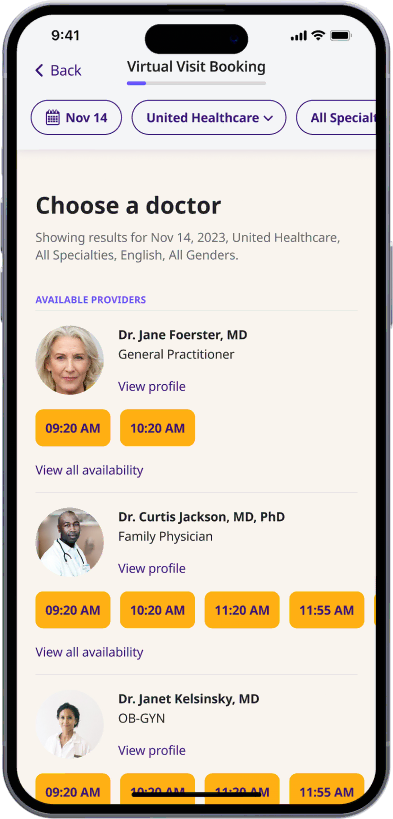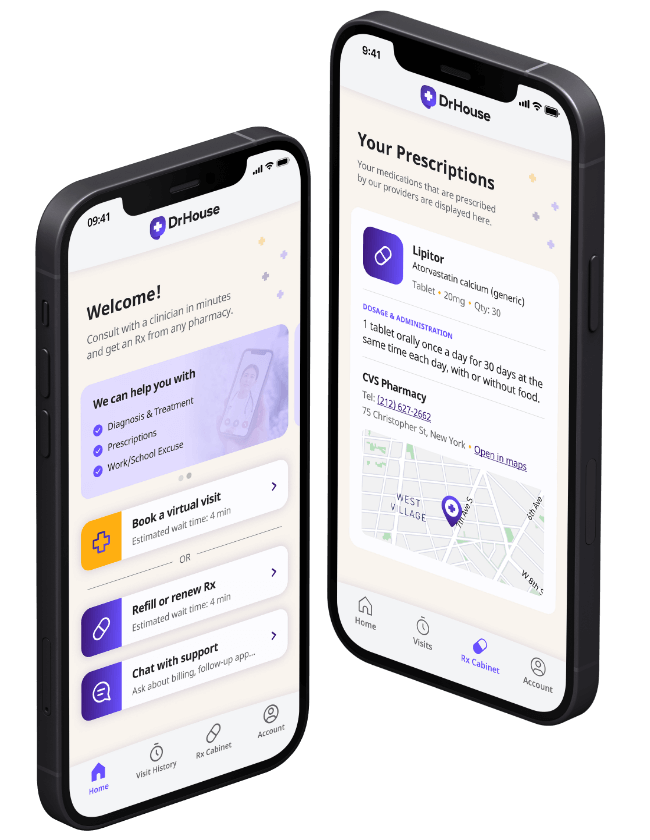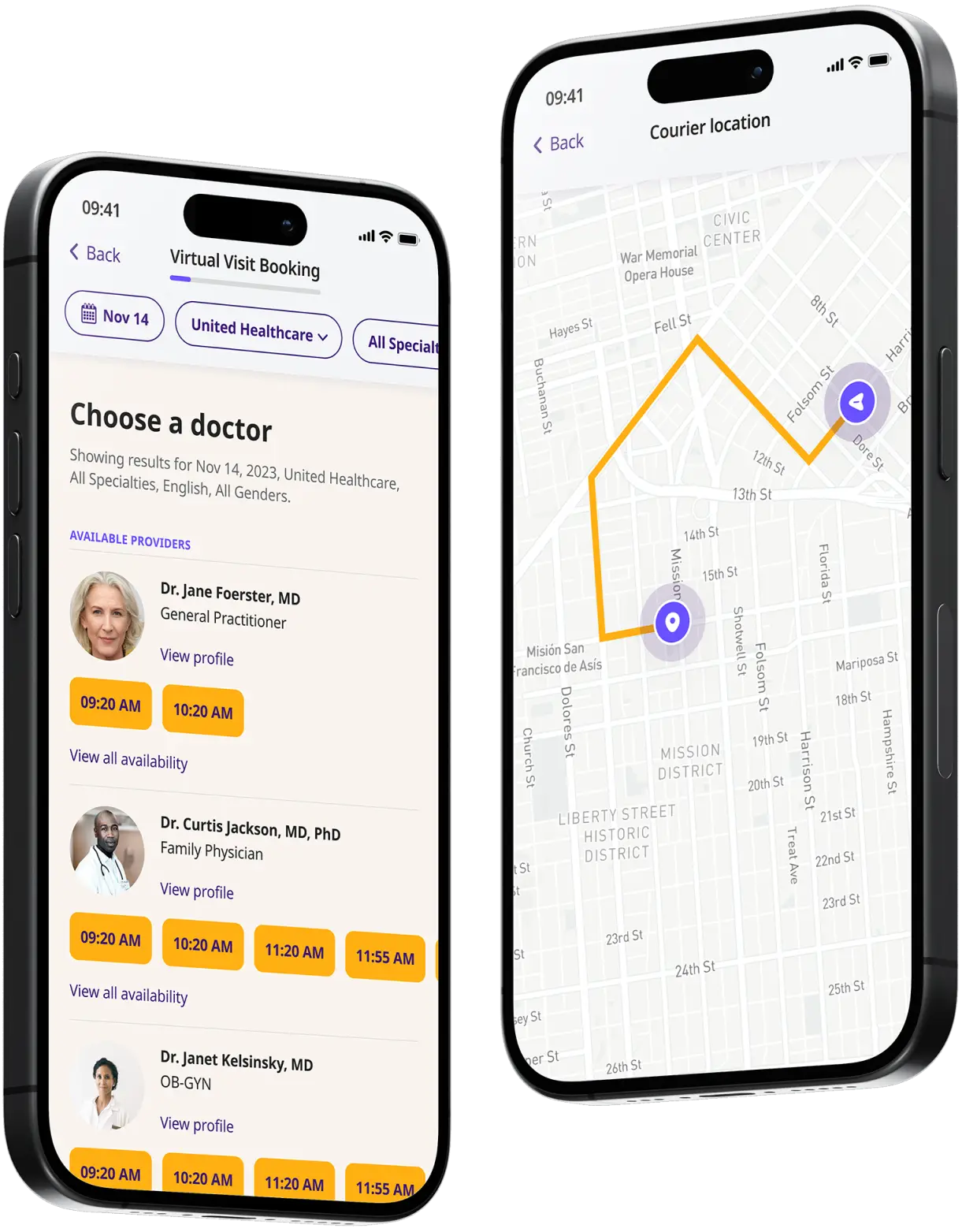Get a Prescription for Antibiotics Online 24/7
Get antibiotics prescribed online - manage bacterial infections with a virtual doctor visit for quick diagnosis and treatment.


Available in 50 states. Insurance accepted.
Fast
virtual visits
24/7 care
assistants
Prescriptions
as needed

24/7 Personal Care
Consult with a physician in 15 minutes, refill an Rx or chat with our care assistants.

Affordable & Convenient
See your cost upfront and get treatment for hundreds of different conditions.

Insurance Accepted
We accept most major insurance plans, making healthcare easy and affordable.
See If Delivery Is Available Near You
Delivery Not Available
Enter your ZIP code to check if prescription delivery is available in your area and how soon your meds could arrive.
How to get started
Choose your doctor, start a virtual visit, and have your prescriptions sent to your preferred pharmacy for pickup — all in just a few easy steps.
Choose a doctor
Choose a physician by availability, specialty, ratings, and more.

Start your video visit
Connect with a doctor in minutes on a secure video call.

Get your prescription
Pick up your meds or have them delivered in as little as an hour.

Available in 50 states. Insurance accepted.
One-Time
Physician Visit
One-time visit with a physician for diagnosis, treatment, Rx, labs, referrals, and doctor’s notes.
Accepted Insurances
See why people turn to DrHouse...
As seen in

Antibiotics
Understanding Antibiotics
Antibiotics are medicines that treat infections caused by bacteria. They work by either killing bacteria or stopping them from multiplying so your body’s immune system can fight off the infection. They are an important part of modern medicine and have saved countless lives by treating illnesses that used to be very dangerous.
It’s important to know that antibiotics only work against bacteria. They do not treat viruses like the common cold, the flu, or COVID-19. Using antibiotics for viral infections is not only ineffective, it can also contribute to bigger problems such as antibiotic resistance, which makes future infections harder to treat.
Quick facts about antibiotics
- Treat bacterial infections only
- Not effective against colds or the flu
- Work by killing bacteria or slowing their growth
- Must be prescribed by a doctor
- Misuse can lead to antibiotic resistance
- Always complete the full course for best results
- Some of the most common antibiotics include amoxicillin, azithromycin, ciprofloxacin, doxycycline, cephalexin, and clindamycin
How Antibiotics Work
Antibiotics are designed to target bacteria in your body without harming your own cells. They do this in two main ways. Some antibiotics kill bacteria directly by breaking down their cell walls or interfering with vital processes they need to survive. Others work by stopping bacteria from multiplying, giving your immune system the time and support it needs to fight off the infection.
A good way to think about it is like this: one type of antibiotic acts as a “destroyer,” wiping bacteria out completely, while another type acts as a “blocker,” preventing bacteria from spreading until your body’s natural defenses clear the rest.
There are also differences in how wide their reach is. Broad-spectrum antibiotics are powerful because they work against many different types of bacteria at once. These are often used when the exact bacteria causing an infection isn’t known. Narrow-spectrum antibiotics, on the other hand, are more targeted. They work against specific bacteria and are preferred when a doctor knows what’s causing the infection, since they protect more of the healthy bacteria in your body.
Both types are useful, but doctors try to use narrow-spectrum antibiotics whenever possible. This approach lowers the risk of antibiotic resistance and reduces side effects by leaving your body’s “good bacteria” mostly untouched.
In the simplest terms: antibiotics either kill bacteria or stop them from spreading. The choice between broad-spectrum and narrow-spectrum depends on your symptoms, test results, and the type of infection being treated.
Common Conditions Treated with Antibiotics
Antibiotics are only useful when bacteria are the cause of an illness. Many common health problems, such as colds, the flu, or most sore throats, are viral and do not improve with antibiotics. But when bacteria are the culprit, these medicines can be the key to recovery. Some of the most frequent conditions treated with antibiotics include:
- Strep throat – A bacterial infection that causes severe throat pain, fever, and swollen tonsils. Antibiotics not only ease symptoms but also prevent serious complications like rheumatic fever.
- Sinus infections – While most sinus problems are viral, bacterial sinus infections that linger more than 10 days, cause facial pain, or lead to worsening symptoms may require antibiotics.
- Urinary tract infections (UTIs) – Very common in women and sometimes men, UTIs cause burning during urination, urgency, and discomfort. Without antibiotics, the infection can spread to the kidneys and become serious.
- Ear infections – Especially in children, ear infections can be caused by bacteria that lead to ear pain, fever, and fluid buildup. Antibiotics help prevent hearing loss or repeated infections.
- Pneumonia – A lung infection that can be caused by bacteria, viruses, or fungi. When bacterial, antibiotics are essential and can be life-saving. Symptoms often include cough, chest pain, fever, and shortness of breath.
- Skin infections – Infections like cellulitis, impetigo, or infected cuts often require antibiotics to stop the bacteria from spreading deeper into the skin or bloodstream.
- Bronchitis – Most cases are viral, but when caused by bacteria or when symptoms are severe and long-lasting, antibiotics may be prescribed.
- Dental infections – Abscesses and other oral infections are sometimes treated with antibiotics to prevent bacteria from spreading before or after dental procedures.
- Sexually transmitted infections (STIs) – Certain bacterial STIs like chlamydia, gonorrhea, and syphilis are treated with specific antibiotics.
Not every case of these conditions needs antibiotics. Doctors decide based on symptoms, duration, test results, and overall health. The goal is to prescribe antibiotics only when they will truly help, which protects patients from unnecessary side effects and helps fight the larger problem of antibiotic resistance.
Common Antibiotics Prescribed
There are many different types of antibiotics, and each one is used for specific kinds of infections. Here are some of the most commonly prescribed:
- Amoxicillin – Often prescribed for strep throat, ear infections, and pneumonia. It is one of the most widely used antibiotics because it works well for common bacterial illnesses.
- Azithromycin (Z-Pak) – Used for sinus infections, bronchitis, and some sexually transmitted infections. Doctors sometimes choose it because it has a shorter treatment course compared to other antibiotics.
- Ciprofloxacin – Commonly used for urinary tract infections (UTIs). It is a strong antibiotic and is generally reserved for cases where other options may not work.
- Doxycycline – Prescribed for acne, respiratory infections, and certain tick-borne illnesses like Lyme disease. It is also sometimes used for malaria prevention when traveling.
- Cephalexin – Often used for skin infections, strep throat, and other mild to moderate bacterial infections. It belongs to the cephalosporin family of antibiotics.
- Clindamycin – Frequently prescribed for more serious infections, including skin and dental infections. It can also be used when patients are allergic to penicillin.
The choice of antibiotic depends on the type of bacteria causing the infection, the severity of symptoms, and a person’s medical history. Doctors select the most effective option while aiming to minimize side effects and avoid unnecessary antibiotic use.
Forms and Dosage
Antibiotics come in several forms, and the type prescribed usually depends on the infection, the patient’s age, and how severe the illness is.
- Tablets and capsules – The most common form, taken by mouth for infections like strep throat, UTIs, and sinus infections.
- Liquids – Often prescribed for children or adults who have trouble swallowing pills. The dose is carefully measured with a syringe or spoon.
- Topical creams and ointments – Used directly on the skin to treat local infections such as impetigo or infected cuts.
- Injections – Sometimes given in a clinic or hospital for more serious infections that need quick and strong treatment.
The length of treatment can vary. Some antibiotics are taken for just a few days, while others may be needed for one to two weeks. Even if symptoms improve early, it is important to finish the full course. Stopping too soon can leave some bacteria alive, which increases the risk of the infection returning and contributes to antibiotic resistance.
Safety and Precautions
While antibiotics can be highly effective, safety and proper use are essential. These medicines should only be taken when prescribed by a doctor, and following the instructions exactly is the best way to recover while avoiding unnecessary risks.
Key safety takeaways about antibiotics
- Antibiotics only treat bacterial infections, not viral illnesses like colds or the flu
- Misusing antibiotics, such as not finishing the full course or taking them without a prescription, can lead to antibiotic resistance
- Some infections and symptoms require in-person care or lab testing before antibiotics are prescribed
- DrHouse doctors may order lab tests before prescribing, especially when the diagnosis is unclear or if symptoms suggest a more serious infection
- Antibiotic refills are not given without a new evaluation, either through updated labs, a fresh diagnosis, or a follow-up visit if the condition is ongoing
- Certain conditions may require longer-term antibiotic use, but this is only done when medically appropriate and under close supervision
- Side effects are possible, ranging from mild stomach upset to rare but serious allergic reactions
- Antibiotics can interact with alcohol, birth control pills, and blood thinners, so it’s important to discuss medications you’re already taking
- Children, pregnant individuals, and older adults may require extra caution and tailored treatment
Risks of Misuse & Antibiotic Resistance
Antibiotics are powerful medicines, but they only work when used correctly. Misuse not only reduces their effectiveness for you, it also creates a bigger health problem for everyone.
Examples of antibiotic misuse include:
- Stopping treatment early because you “feel better”
- Saving leftover pills and taking them later without medical advice
- Sharing antibiotics with family or friends
- Taking antibiotics for viral illnesses like colds, the flu, or COVID-19
- Using antibiotics without a proper diagnosis or prescription
When antibiotics are misused, some bacteria survive instead of being killed off. Over time, these stronger bacteria adapt and become resistant. This means the same antibiotic may no longer work the next time you get sick.
Antibiotic resistance is now considered one of the biggest public health concerns worldwide. Infections that were once simple to treat are becoming harder to cure, leading to longer illnesses, more hospital visits, and in severe cases, life-threatening complications.
The best way to protect yourself and others is to use antibiotics exactly as prescribed, never skip doses, and always complete the full course, even if you feel better before it’s finished.
Side Effects of Antibiotics
Most people take antibiotics without major problems, but side effects can happen. They vary by medicine, dose, and your health. Knowing what is common and what is serious helps you act early and safely.
Common side effects
- Upset stomach, nausea, or vomiting. Often improves if the dose is taken with food when the label allows it.
- Mild diarrhea or softer stools. Stay hydrated. Call a doctor if it becomes severe or lasts more than a couple of days.
- Stomach pain, gas, or cramps. Small meals and fluids can help.
- Headache or feeling tired.
- Dizziness or lightheadedness. Stand up slowly. Do not drive if you feel unsafe.
- Changes in taste or a metallic taste. Usually temporary.
- Loss of appetite.
- Yeast infections. Vaginal itching or discharge, or white patches in the mouth called thrush. These are treatable, so let a clinician know.
- Mild skin rash or itching. Stop and call a doctor if the rash spreads or you feel unwell.
- Sun sensitivity. More likely with doxycycline and some other antibiotics. Use sunscreen, wear protective clothing, and avoid tanning beds.
- Local irritation from topical antibiotics. Redness, dryness, or a stinging feeling at the application site.
- Injection site soreness if you receive an antibiotic shot.
Less common but important
- Severe diarrhea that may signal C. difficile infection. Watery diarrhea three or more times a day for over two days, belly cramps, fever, or stool with blood or mucus. This needs medical care.
- Allergic reactions. Hives, swelling of lips or face, wheezing, or trouble breathing. This is an emergency. Call your local emergency number.
- Tendon pain or swelling. Pain in the Achilles tendon, shoulder, or wrist can happen with fluoroquinolones such as ciprofloxacin. Stop the medicine and contact a doctor right away.
- Heart rhythm problems. Fast or irregular heartbeat can occur with some antibiotics like azithromycin or certain fluoroquinolones, especially in people with heart conditions or on other rhythm-affecting drugs.
- Liver issues. Yellow skin or eyes, dark urine, severe fatigue, or pain in the upper right belly. Seek care.
- Kidney issues. Peeing less, swelling in legs or feet, back pain, or blood in the urine. Seek care.
- Severe skin reactions. Blistering, peeling skin, or sores in the mouth or eyes. This is urgent.
- Blood sugar changes. Very low or very high sugar can occur with some fluoroquinolones. Watch closely if you have diabetes.
- Seizures or severe confusion. Rare but serious, especially in people with certain conditions or drug interactions.
- Blood problems. Easy bruising, unusual infections, or extreme fatigue can signal low blood counts. Contact a clinician.
How to lower the chance of side effects
- Take the medicine exactly as directed. Some antibiotics should be taken with food, some on an empty stomach. Check the label.
- Swallow pills with a full glass of water. Stay upright for 30 minutes after doxycycline to reduce throat irritation.
- Space out probiotics from your antibiotic by at least two hours if you choose to use them. They may help with mild diarrhea. Ask a clinician first if your immune system is weak.
- Protect your skin from the sun if your antibiotic can cause photosensitivity.
- Do not drink alcohol if your label warns against it. Metronidazole and a few others can cause severe reactions with alcohol.
- If you miss a dose, take it when you remember unless it is close to the next dose. Do not double up.
When to get help now
- Trouble breathing, swelling of the face or throat, or severe hives.
- Severe or persistent diarrhea, especially with fever or blood.
- Vomiting that prevents you from keeping fluids down.
- Severe belly pain, chest pain, fainting, or a very fast or irregular heartbeat.
- Yellowing of the skin or eyes, very dark urine, or severe fatigue.
- New tendon pain, swelling, or sudden popping sensation.
Most side effects are mild and pass, but a few are serious. Know the warning signs, follow directions closely, and contact a clinician if anything worries you.
Drug Interactions & Special Considerations
Antibiotics don’t just interact with bacteria — they can also interact with other medicines, foods, and even lifestyle habits. While most people take antibiotics safely, certain situations require extra caution.
Alcohol
- Drinking alcohol while on antibiotics can make side effects worse, such as nausea, dizziness, or drowsiness.
Some antibiotics, like metronidazole and tinidazole, can cause severe reactions with alcohol, including vomiting, flushing, and rapid heartbeat. - Even with antibiotics that don’t directly react with alcohol, avoiding drinking helps your body focus on fighting the infection.
Birth control
- Some antibiotics, such as rifampin (less commonly prescribed), can reduce the effectiveness of hormonal birth control methods like the pill, patch, or ring.
- While most antibiotics do not interfere, doctors often recommend using a backup method like condoms during treatment and for a short time after, just to be safe.
Blood thinners (anticoagulants)
- Antibiotics like ciprofloxacin, clarithromycin, and metronidazole can affect how blood thinners such as warfarin work.
- This can increase the risk of bleeding or reduce the effectiveness of the blood thinner. If you are on anticoagulants, your doctor may adjust the dose or monitor you more closely.
Children
- Not all antibiotics are safe for children. For example, tetracyclines like doxycycline are generally avoided in young children because they can affect bone growth and stain teeth.
- Doctors carefully choose antibiotics and dosages based on age and weight.
Pregnancy
- Some antibiotics are safe during pregnancy, but others, such as tetracyclines, should be avoided because they can harm the baby’s development.
- Doctors balance the risks and benefits carefully, sometimes recommending lab tests before prescribing.
Older adults
- Older adults may be more sensitive to antibiotic side effects, especially kidney or liver problems.
- They are also more likely to be taking other medications, which increases the chance of interactions.
Always let your doctor know about any medications you’re taking, if you’re pregnant or breastfeeding, or if you’re caring for a child or elderly adult. This helps ensure that the antibiotic prescribed is both safe and effective for your situation.
When DrHouse May Not Prescribe Antibiotics
Antibiotics are only helpful when bacteria are the cause of an illness. Because of this, there are times when DrHouse doctors will not prescribe them. This is not to withhold treatment, but to make sure you get the right care and avoid unnecessary risks.
Viral infections
- Antibiotics do not work against viruses such as the common cold, the flu, or COVID-19.
- In these cases, rest, fluids, and over-the-counter medicines for symptom relief are usually the best approach.
- If symptoms worsen or suggest a bacterial complication, a doctor may reassess and decide whether antibiotics are needed.
Mild, self-limiting conditions
- Many minor illnesses get better on their own without antibiotics. Examples include some mild ear infections, minor skin irritations, or short-lived sinus infections.
- Prescribing antibiotics in these cases provides little benefit and increases the risk of side effects or resistance.
Conditions requiring in-person tests
- Some serious infections cannot be safely treated with a virtual visit alone. Situations like suspected sepsis, meningitis, or very severe pneumonia need urgent in-person care, often with lab tests, imaging, or hospital treatment.
- In these cases, DrHouse doctors may refer you for further evaluation to make sure you get the level of care that is safest.
The goal is always to provide the right treatment, not just the fastest one. By prescribing antibiotics only when appropriate, DrHouse protects your health now and also helps ensure these medicines remain effective in the future.
Antibiotics and DrHouse
Getting the right treatment for a bacterial infection doesn’t have to mean waiting days for an appointment or sitting in a crowded clinic. With DrHouse, you can connect with a licensed doctor from home, get a proper diagnosis, and receive antibiotics when they’re truly needed. Our doctors carefully evaluate your symptoms, prescribe responsibly, and can even arrange fast prescription delivery so you start feeling better sooner.
Key takeaways about antibiotics with DrHouse
- Licensed doctors available 24/7 through the DrHouse app
- Virtual visits that are fast, secure, and convenient
- Antibiotics prescribed only when medically appropriate
- Coverage for common conditions like UTIs, sinus infections, strep throat, and more
- Prescriptions sent directly to your local pharmacy or delivered to your door in as little as 60 minutes
- Works with major insurance providers and offers clear, upfront pricing
- Nationwide availability so you can access care wherever you are
Online Doctor Visits for Antibiotics
With DrHouse, getting evaluated for antibiotics is fast and convenient. You can connect with a licensed doctor directly through the app, share your symptoms and medical history, and get a thorough virtual consultation. If antibiotics are appropriate, the doctor will prescribe the right medication and send it to your pharmacy of choice or arrange delivery straight to your door, often within the hour.
Doctors prescribe antibiotics only when they are necessary. Through a virtual visit, DrHouse can treat a wide range of common bacterial infections, including:
- Urinary tract infections (UTIs)
- Strep throat
- Sinus infections
- Ear infections
- Skin infections such as cellulitis, impetigo, or infected cuts
- Respiratory infections like bronchitis or mild pneumonia
- Dental infections that require antibiotics to stop bacteria from spreading
- Sexually transmitted infections (STIs/STDs)
If your condition requires in-person testing or urgent hospital care, your doctor will explain why and direct you to the right next step. This way, you receive safe, effective treatment without unnecessary delays.
Prescriptions Made Simple
With DrHouse, the process of getting antibiotics is designed to be quick and stress-free. After your virtual consultation, if the doctor determines that antibiotics are appropriate, a prescription is written right away. You then have two options: pick it up from your local pharmacy or choose on-demand delivery and have your medication brought directly to your door, often within 60 minutes.
DrHouse accepts most major health insurance plans, making care both accessible and affordable. This includes Blue Cross Blue Shield, Aetna, UnitedHealthcare, Medicare, Humana, and Elevance Health (formerly Anthem). Coverage may vary depending on your individual plan, but our platform provides transparent pricing so you always know what to expect.
The goal is simple: connect with a doctor, get the right treatment, and start feeling better without unnecessary delays.
Frequently Asked Questions
Can I Get Antibiotics Online Without Seeing a Doctor?
No, antibiotics are prescription-only medications. To make sure they’re used safely, you must be evaluated by a licensed doctor first. With DrHouse, that evaluation happens virtually through the app. A doctor reviews your symptoms, medical history, and overall health before deciding if antibiotics are appropriate. If they are, a prescription is sent directly to your pharmacy or delivered to your home.
How Do I Know if My Infection Needs Antibiotics?
Not all infections require antibiotics. Viral illnesses like colds or the flu do not improve with them, while bacterial infections often do. Some signs that an infection might need antibiotics include a fever that doesn’t improve, symptoms that get worse instead of better, or conditions known to be caused by bacteria such as strep throat or a urinary tract infection. The only way to know for sure is to be evaluated by a doctor, since symptoms of viral and bacterial infections often overlap.
How Fast Do Antibiotics Start Working?
Most antibiotics start working quickly after the first dose, but it can take a day or two before you notice relief. For some conditions, like strep throat or UTIs, symptoms often improve within 24–48 hours. For others, it may take several days. Even if you feel better, it’s important to finish the full course of antibiotics so the infection doesn’t come back stronger.
What Happens if I Stop Taking Antibiotics Early?
Stopping antibiotics before finishing your prescription can allow some bacteria to survive. These bacteria may grow back stronger and more resistant, making the infection harder to treat in the future. Even if your symptoms improve, always complete the full course prescribed by your doctor. If you experience side effects that make it difficult to continue, contact your doctor right away instead of stopping on your own.
Can Antibiotics Treat Viral Infections Like Colds or the Flu?
No, antibiotics do not work against viruses. Colds, the flu, most sore throats, and many sinus infections are caused by viruses, and antibiotics won’t help. Taking antibiotics for viral illnesses not only exposes you to unnecessary side effects but also contributes to antibiotic resistance. For viral infections, rest, fluids, and supportive care are usually the best approach, though a doctor can sometimes recommend antiviral medications if appropriate.
Are Antibiotics Safe to Take During Pregnancy or While Breastfeeding?
Some antibiotics are safe during pregnancy and breastfeeding, but not all. Medicines like penicillin, amoxicillin, and certain cephalosporins are generally considered safe, while others, such as tetracyclines, are avoided because they can affect the baby’s development. The right choice depends on the type of infection and your medical history. Always let your doctor know if you are pregnant or breastfeeding so they can prescribe the safest option for you and your baby.
What Side Effects Should I Watch Out for With Antibiotics?
Most antibiotics are well tolerated, but side effects can happen. Common ones include nausea, upset stomach, diarrhea, headache, or yeast infections. Some antibiotics may also make your skin more sensitive to sunlight. Rare but serious side effects include allergic reactions (trouble breathing, swelling, rash), severe diarrhea from C. diff infection, or unusual pain in tendons and joints. If you notice anything severe or unexpected, stop the medication and contact a doctor right away.
Can Antibiotics Interfere With Birth Control or Other Medications?
Most antibiotics do not affect hormonal birth control, but a few, such as rifampin, can lower its effectiveness. Antibiotics can also interact with other medications, including blood thinners like warfarin, leading to an increased risk of bleeding. Always tell your doctor about any medications, supplements, or birth control you are using before starting antibiotics so they can prescribe safely.
Does Drhouse Prescribe Antibiotics for Children?
Yes, DrHouse doctors can evaluate and prescribe antibiotics for children when appropriate. The prescription will depend on the child’s age, weight, symptoms, and medical history. Some conditions, such as ear infections, strep throat, or skin infections, are commonly treated with antibiotics in children. In certain cases, a doctor may recommend in-person evaluation or lab tests to ensure the best care for your child.
Related services
Explore more of our services tailored to your needs and discover additional ways we can support your healthcare needs.
Frequently asked questions




